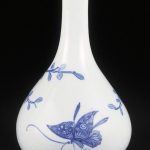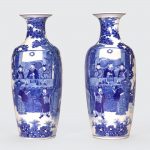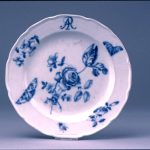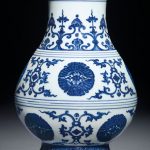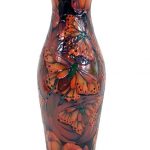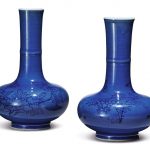“Blue and white ceramics or pottery” covers a wide range of white pottery and porcelain decorated under the glaze with a blue pigment, generally cobalt oxide. The decoration is commonly applied by hand, originally by brush painting, but nowadays by stencilling or by transfer-printing, though other methods of application have also been used. The cobalt pigment is one of the very few that can withstand the highest firing temperatures that are required, in particular for porcelain, which partly accounts for its long-lasting popularity. Historically, many other colours required overglaze decoration and then a second firing at a lower temperature to fix that.
The origin of this decorative style is thought to lie in Iraq, when craftsmen in Basra sought to imitate imported white Chinese stoneware with their own tin-glazed, white pottery and added decorative motifs in blue glazes. Such Abbasid-era “blue and white” pieces have been found in present-day Iraq dating to the 9th century A.D., decades after the opening of a direct sea route from Iraq to China. Reference: Wikipedia
Below are some examples, information and price guides to blue and white ceramics which depict butterflies, including a wine flask and a blue and white butterfly vase.
Wine flask of porcelain. The body is painted in underglaze blue with branches of flowering peony and a butterfly.
White porcelain, made from a mixture of clay and crushed rock fired at a very high temperature, was first produced in Korea in the Koryo dynasty (918–1392). By the time this wine flask was made in the 19th century such porcelain had come to dominate ceramic production. Plain white wares, with their connotations of purity and honesty, were popular in a culture embedded in Confucian philosophy. However, porcelains painted under the glaze with iron brown, copper red and, as in this case, cobalt blue were also prized. Korean art is rich in symbolism: the butterfly on this example represents a wish for long life.
Reference: © Victoria and Albert Museum
Sake Bottle (“Tokkuri”) with Boys Chasing Butterflies. This is an example of Hirado ware.
Circa 1830-1860 (Edo)
Reference: The Walters Art Museum
A PAIR OF BLUE AND WHITE OVOID VASES Kangxi marks, late Qing/Republic period The thin waisted necks and tall bodies covered in mirrored continuous figural tableaux depicting a judicial process in a rocky butterfly and scholar’s rock strewn garden, all rendered in varied hues of deep cobalt blue; the bases bearing the six-character mark in standard script. 17 3/4in (45cm) high
Sold for US$ 5,075 (£ 4,001) inc. premium at Bonham’s in 2019
Plate; hard-paste porcelain; moulded, with undulating rim; greyish-white body painted in underglaze-blue with a large spray of flowers in the centre and round the rim two butterflies, two small flower sprays and AR in monogram; marked. Meissen Porcelain Factory biography Date 1750 (circa)
Reference: © The Trustees of the British Museum
AN UNUSUAL BLUE AND WHITE ‘BUTTERFLY’ VASE, HU YONGZHENG PERIOD (1723-1735) Of archaistic hu form, the exterior is decorated with three registers, the lower two with four medallions of two butterflies alternating with connected scrolls, the neck with connected scrolls supporting ruyi heads. The registers are divided by triple raised ribs, repeated below the mouth rim. The splayed foot is painted with ruyi heads. 9 1/4 in. (23.7 cm.) high, Japanese box
Pairs of confronting butterflies appeared as a decorative motif on Chinese works of art from as early as the Tang dynasty on gold and silver wares and pottery pillows. In the Song dynasty they appeared on Yue and Ding ware pieces, but then seemed to have disappeared on porcelain pieces of the Yuan and Ming dynasties. They did not become popular until the 18th century, and the Yongzheng Emperor seemed to be especially fond of them.
Sold for HKD 810,000 at Christie’s in 2013
Louis XVI Style Gilt-Bronze Mounted Chinese Export Blue and White Glazed Porcelain Basin The bulbous body painted with floral swags, rising from a splayed foot to the everted rim, the interior decorated with floral sprays and scattered butterflies, flanked by two rams’ head mounts. Length of porcelain 26 1/2 inches (67.31 cm)
Basin in overall good condition with kiln imperfections, rubbing to gilt-bronze mounts, especially to base, base loose, metal plate to underside rusted and loose, lacking bottom nut to secure base to bowl, chips to edge of base, rams’ head handles screwed on with nuts to interior
Sold for $6,875 (includes buyer’s premium) at Doyle in 2017

